Introduction
Navigating the journey of diagnosing autism can often feel overwhelming for parents and caregivers. However, understanding the two-step diagnostic process can empower families to seek timely and appropriate support for their children. The process begins with developmental screenings during routine health visits, typically at 18 and 24 months, where professionals and parents collaborate to observe and discuss the child's developmental milestones.
If these screenings indicate potential signs of autism, a comprehensive evaluation involving a multidisciplinary team follows. This thorough evaluation utilizes various diagnostic tools and professional observations to ensure an accurate diagnosis. Early diagnosis is crucial as it opens the door to interventions that significantly enhance social communication and adaptive behaviors, promoting better long-term outcomes for children on the autism spectrum.
This article delves into the essential steps, screening tools, and evaluation components, providing clarity and guidance for parents navigating the autism diagnostic process.
Understanding the Two-Step Diagnostic Process
The process of diagnosing autism involves two key stages: screening and comprehensive evaluation. This journey typically begins with developmental screenings during regular health visits, recommended at ages 18 and 24 months. During these screenings, parents provide descriptions of their child's development, while a professional observes the child's behavior. The American Psychiatric Association's Diagnostic and Statistical Manual, Fifth Edition (DSM-5), outlines standardized criteria used by clinicians to diagnose Autism Spectrum Disorder (ASD), ensuring that core features are present in childhood.
If initial screenings indicate potential signs of autism, a comprehensive evaluation follows. This evaluation involves a multidisciplinary team, including pediatricians, psychologists, and speech-language pathologists, who use various diagnostic tools. No single tool suffices for a diagnosis; instead, a combination of parent/caregiver input and professional observation is essential. Delays in this process are common, with many families facing wait times of over four months for evaluations, and in some cases, waitlists exceeding a year. Such delays can hinder prompt assistance, which is essential for optimizing developmental results.
Prompt diagnosis is crucial as it enables timely action. Research indicates that intensive behavioral programs, which may need 20-40 hours each week, greatly enhance social communication and adaptive behaviors in youth with developmental disorders. However, the benefits of these interventions must be carefully weighed against potential adverse effects due to inadequate monitoring. Overall, comprehending the assessment procedure for developmental disorders enables parents to pursue early and suitable assistance for their offspring's well-being.
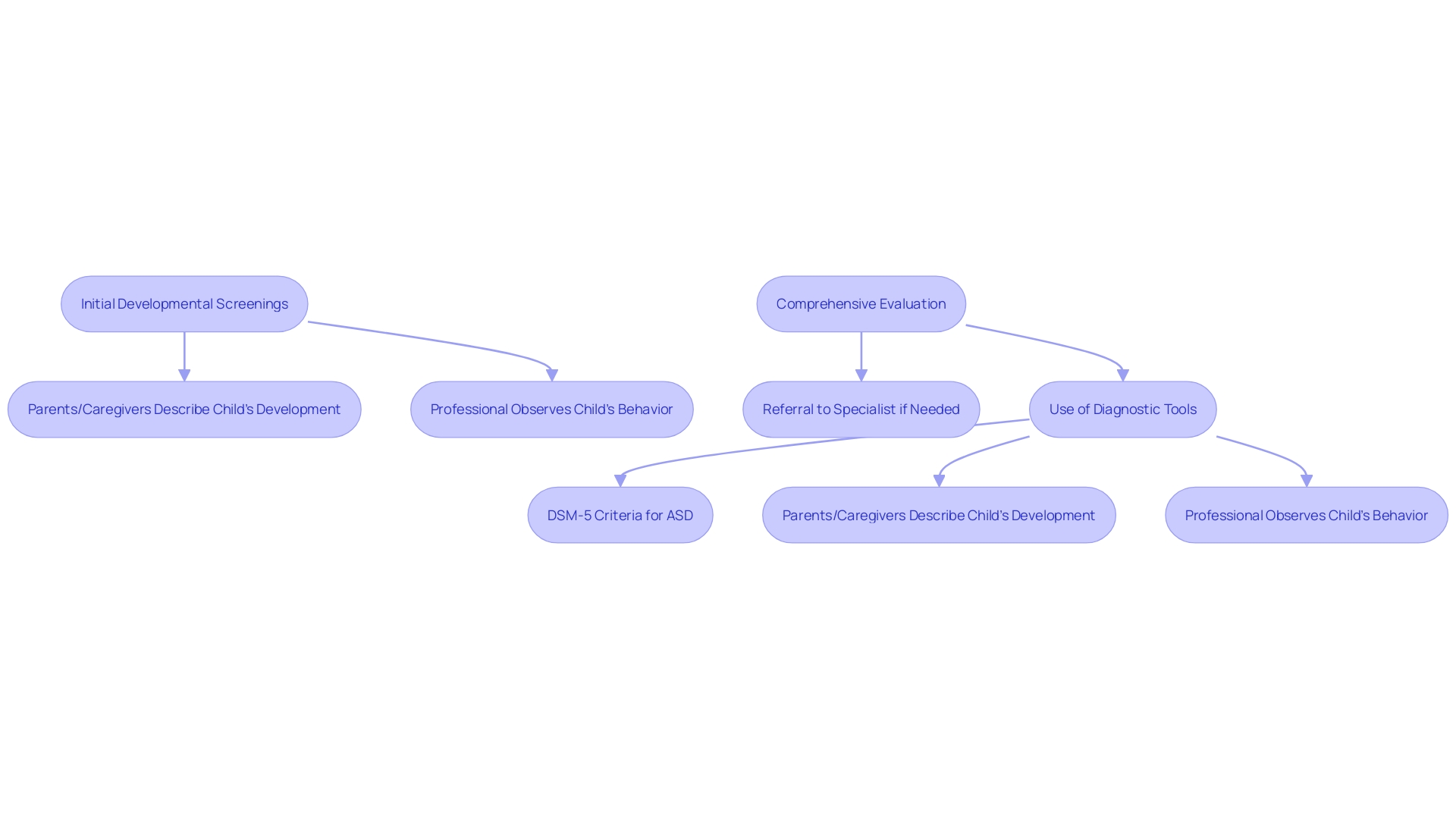
Step 1: Screening for Autism
Screening acts as an essential initial measure in recognizing youth who might be susceptible to developmental disorders. Utilizing research-based, standardized tools, these screenings focus on assessing developmental milestones and behavioral patterns that could indicate the presence of autism spectrum disorder (ASD).
These tools are designed to provide a comprehensive look at a child's initial development, highlighting any areas of concern. Early detection is essential, given that 90% of brain development occurs by the age of five, a period marked by high neuroplasticity. This indicates the brain's capacity to create and reconstruct neural pathways is at its peak, making initial intervention particularly impactful.
Screenings not only help catch developmental delays and behavioral signs indicative of autism but also play a role in addressing broader health-related social needs that might exacerbate developmental issues. For instance, factors like optimal nutrition during the first 1,000 days of life are critical for brain development and overall health. Adverse childhood experiences (ACEs), such as violence or neglect, can disrupt this development, leading to long-term health issues. Consequently, these screenings offer an essential chance to recognize and reduce such risks promptly.
The significance of these initial screenings is further highlighted by their potential to encourage prompt and effective actions. Evidence indicates that developmental strategies can greatly enhance social communication and adaptive behaviors, vital for managing the condition. As Dr. Leandra Berry, head of the developmental program at Texas Children's Hospital in Houston, points out, prompt and dependable diagnosis is essential for obtaining evidence-based treatments sooner, which can have a significant impact on a young person's developmental path.
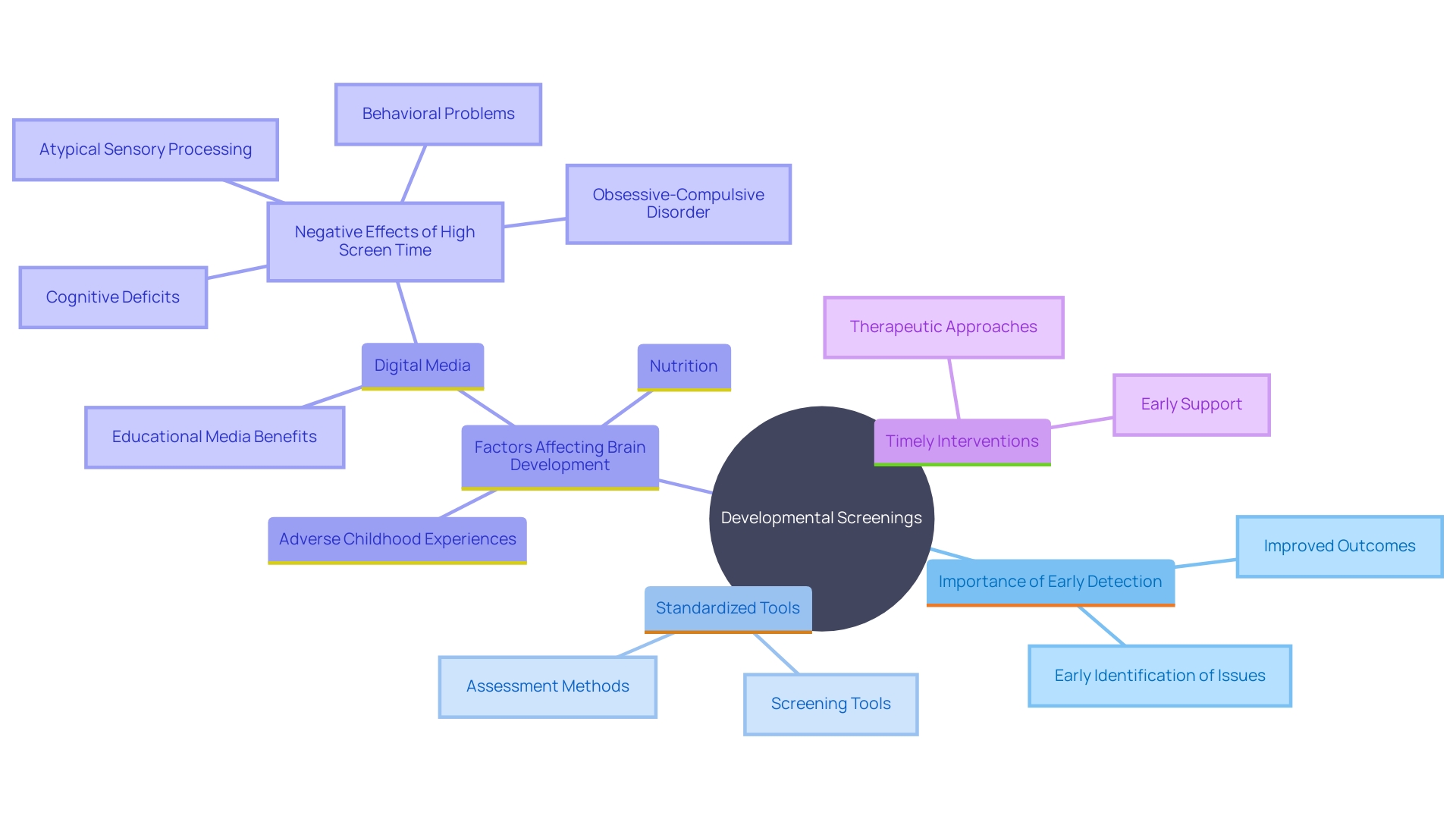
Common Screening Tools
A variety of assessment instruments is crucial in recognizing early indicators of the condition. These tools, often based on standardized criteria from the American Psychiatric Association's Diagnostic and Statistical Manual, Fifth Edition (DSM-5), provide a structured approach to assessing a young person's development. Based on recent statistics, the occurrence of autism spectrum disorder (ASD) in the United States has risen to one in 36 youths, emphasizing the urgent requirement for effective screening methods.
Diagnostic tools generally depend on two primary sources of information: detailed descriptions from parents or caregivers regarding the individual's development and professional observations of the individual's behavior. This dual approach ensures a comprehensive understanding of the young person's developmental trajectory. For example, primary care providers may refer families to specialists such as neurodevelopmental pediatricians, developmental-behavioral pediatricians, or neurologists for a more thorough evaluation when initial screenings suggest possible issues.
The Interagency Autism Coordinating Committee (IACC) has emphasized the importance of prompt screening and diagnosis, especially through innovative methods such as telehealth. This method seeks to close gaps in accessibility and guarantee prompt assistance for all young individuals, irrespective of their background. Data also highlights the effectiveness of developmental programs in enhancing social communication and other fundamental issues linked to neurodevelopmental disorders, further confirming the significance of prompt and precise evaluation.
In conclusion, employing a range of assessment instruments not only assists in the prompt identification of developmental disorders but also sets the stage for timely and suitable interventions, ultimately enhancing the welfare and growth of individuals with ASD.
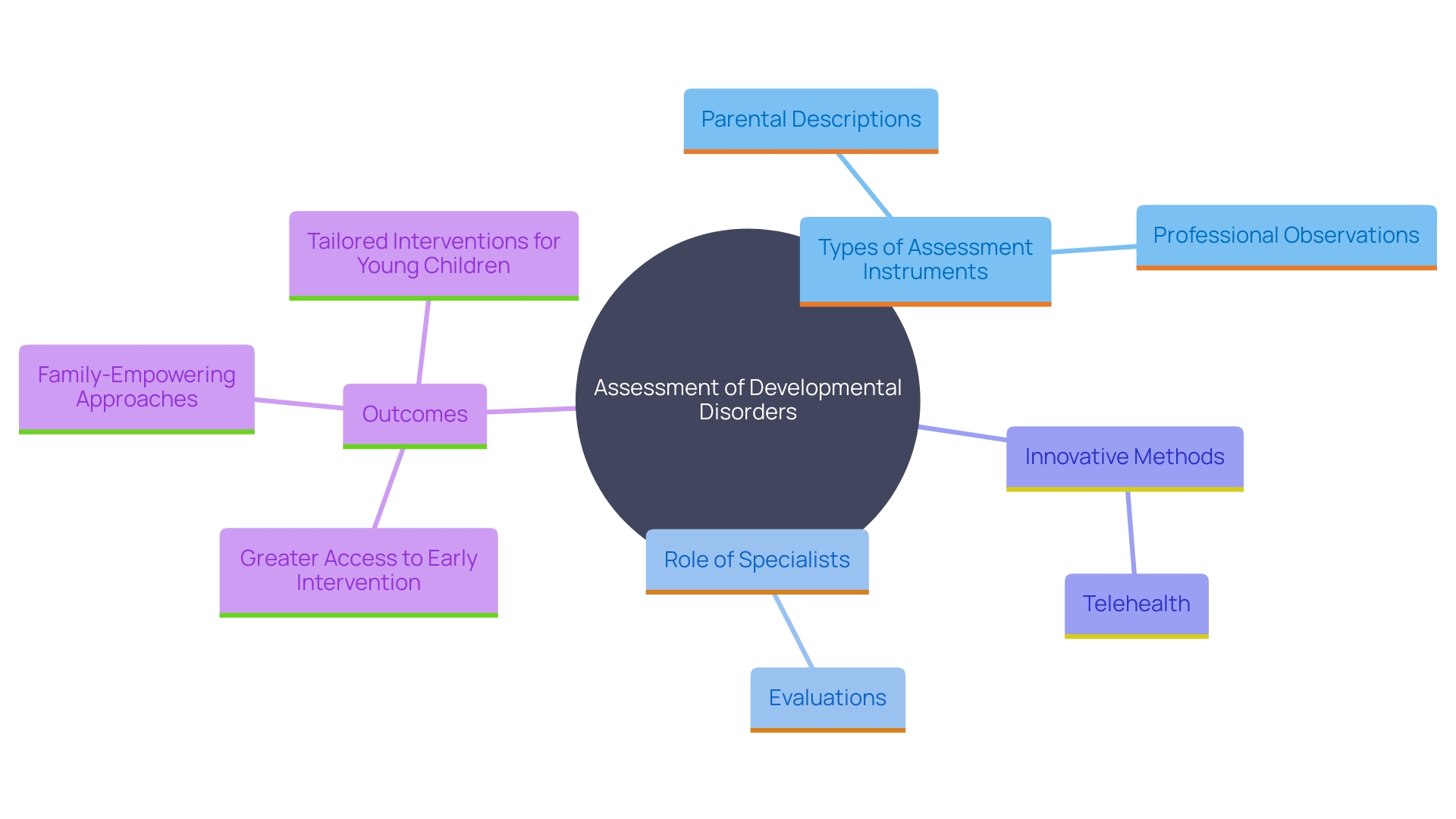
Modified Checklist for Autism in Toddlers, Revised (M-CHAT-R)
The Modified Checklist for Autism in Toddlers, Revised (M-CHAT-R) is a crucial screening tool used to evaluate toddlers between 16 and 30 months for potential signs of autism spectrum disorder (ASD). Parents or caregivers respond to a set of organized inquiries that assist in recognizing initial signs associated with their offspring's social behavior and communication abilities. This tool is instrumental in early detection, allowing for timely intervention that can significantly improve developmental outcomes. Considering that ASD impacts roughly 1 in 36 young individuals in the United States, with rates rising worldwide, available screening tools such as the M-CHAT-R are more crucial than ever.
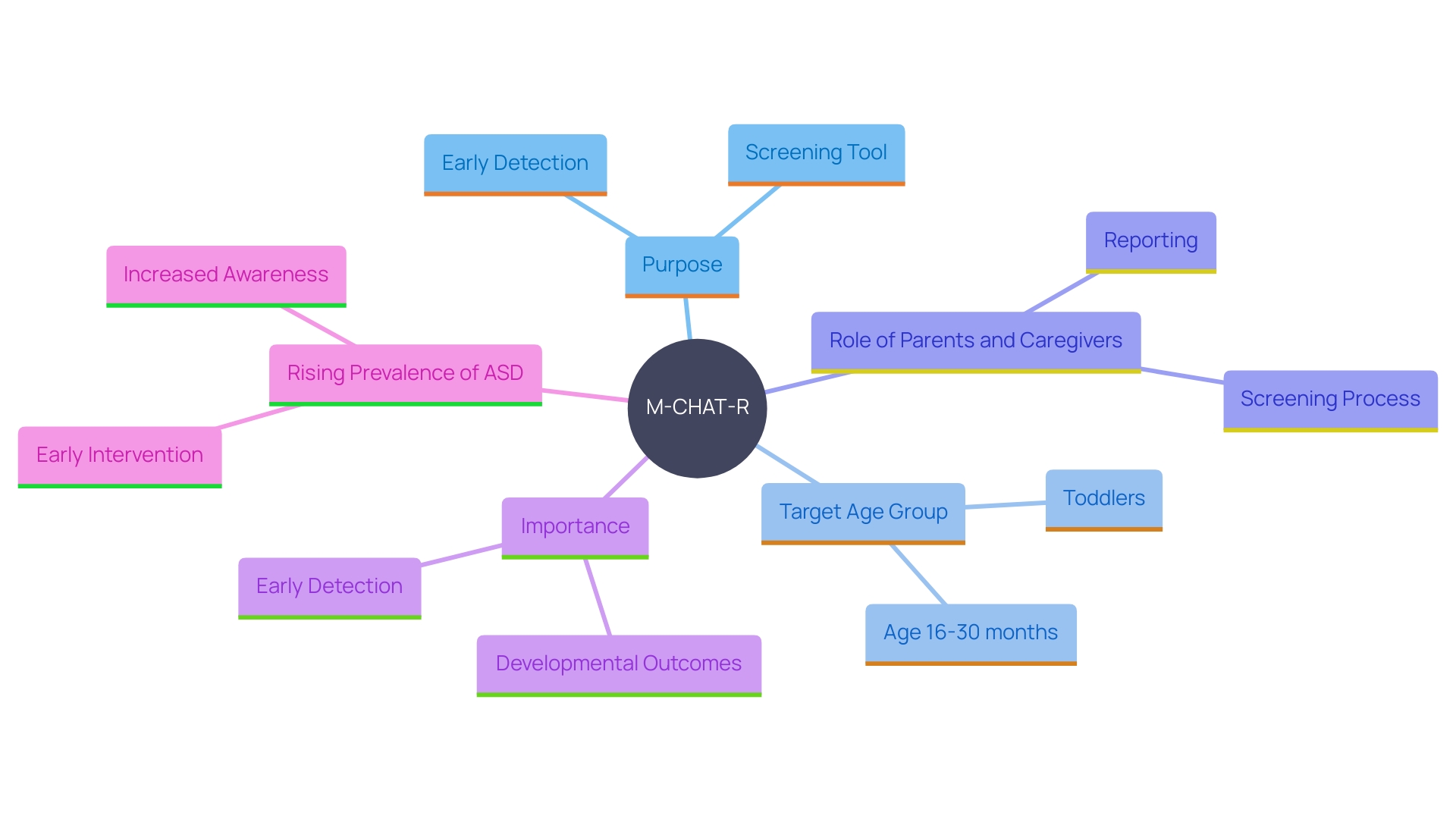
Social Attention and Communication Surveillance, Revised (SACS-R) and SACS-Preschool (SACS-PR)
These tools are invaluable for evaluating younger individuals, particularly focusing on key areas such as social attention and communication. By analyzing these factors, they enable the prompt recognition of developmental disorders in toddlers and preschool-aged children. Prompt identification is vital, as it enables timely actions that can greatly improve developmental results. Research highlights that early childhood programs can enhance social communication skills and reduce core challenges associated with autism. For example, based on a proof-of-concept study, the Brief Observation of Social Communication Change (BOSCC) has demonstrated effectiveness in identifying subtle enhancements in social communication abilities among young individuals undergoing various treatments. These findings highlight the significance of utilizing sensitive and precise tools to track developmental progress and customize approaches effectively.
Social Challenges Screening Questionnaire (SCSQ)
The Social Communication Questionnaire (SCQ) is intended to assess social abilities and interactions, aiding in the identification of children who may face difficulties in social contexts—a typical issue for individuals on the spectrum. Timely identification and support are essential, as developmental programs have been demonstrated to enhance social communication in interactions with caregivers. For instance, naturalistic developmental behavioral approaches specifically focus on the fundamental social challenges linked to the condition. Given that autism spectrum disorder (ASD) affects approximately 1-4% of the population, early childhood interventions are often recommended to promote skill development and positive long-term outcomes. By understanding and utilizing tools like the SCQ, parents and professionals can better support young people's social development and overall well-being.
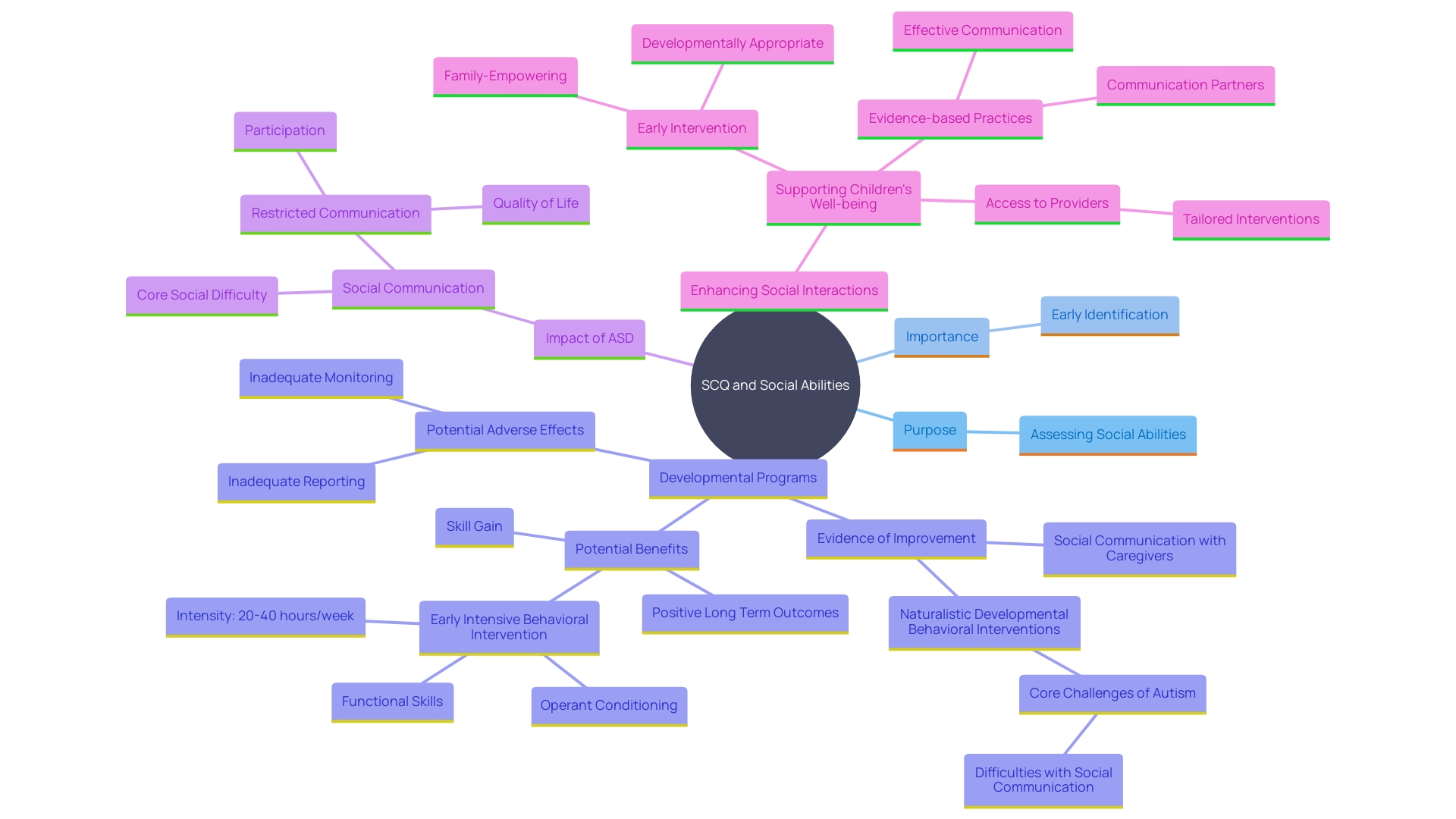
Autism Spectrum Quotient (AQ) Test
The Autism-Spectrum Quotient (AQ) test is a valuable assessment tool designed for older individuals, focusing on identifying autistic traits. This test evaluates various aspects such as social skills, attention to detail, and communication abilities. Utilizing the American Psychiatric Association's DSM-5 criteria, the AQ test aids in identifying core characteristics of the condition that may present differently in individuals. For some, symptoms may not be evident until social demands highlight the challenges. As the occurrence of the developmental disorder rises worldwide, with current estimates showing that one in 36 children in the United States is diagnosed with the condition, tools like the AQ test become essential for early detection and intervention. Timely and precise identification, backed by expert assessment and caregiver contributions, can greatly influence the long-term results for individuals within the spectrum of developmental disorders.
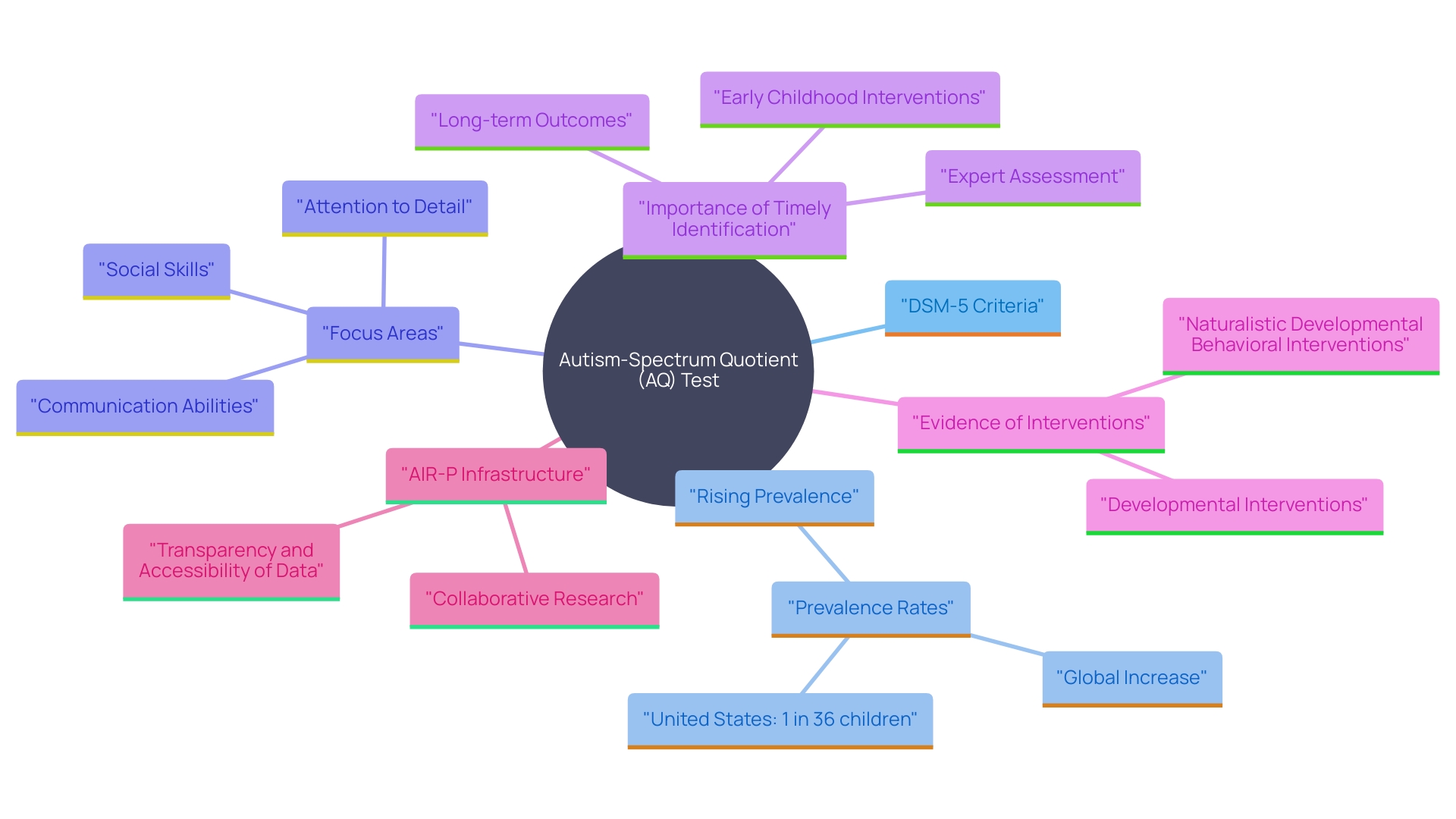
Step 2: Comprehensive Diagnostic Evaluation
When screening results suggest the possibility of autism, the next step is a comprehensive diagnostic evaluation. This thorough process entails collecting comprehensive information regarding the young person's development and behavior. Typically, the evaluation relies on two main sources: the descriptions provided by the parents or caregivers and the observations made by professionals. The American Psychiatric Association's Diagnostic and Statistical Manual, Fifth Edition (DSM-5), offers standardized criteria to aid in diagnosing Autism Spectrum Disorder (ASD). However, no single tool should be used as the basis for diagnosis. Instead, a combination of assessments is utilized to get a complete picture.
In certain cases, the primary care provider may refer the young patient and family to a specialist for further evaluation. These experts may consist of neurodevelopmental pediatricians, developmental-behavioral pediatricians, pediatric neurologists, geneticists, and programs for initial support. Such referrals are vital as they assist in guaranteeing that young individuals obtain a precise diagnosis and access to early support during the essential initial neurodevelopmental phase. Prompt actions can greatly enhance social interaction and tackle fundamental issues linked to developmental disorders, rendering timely and precise identification crucial for the individual's long-term welfare.
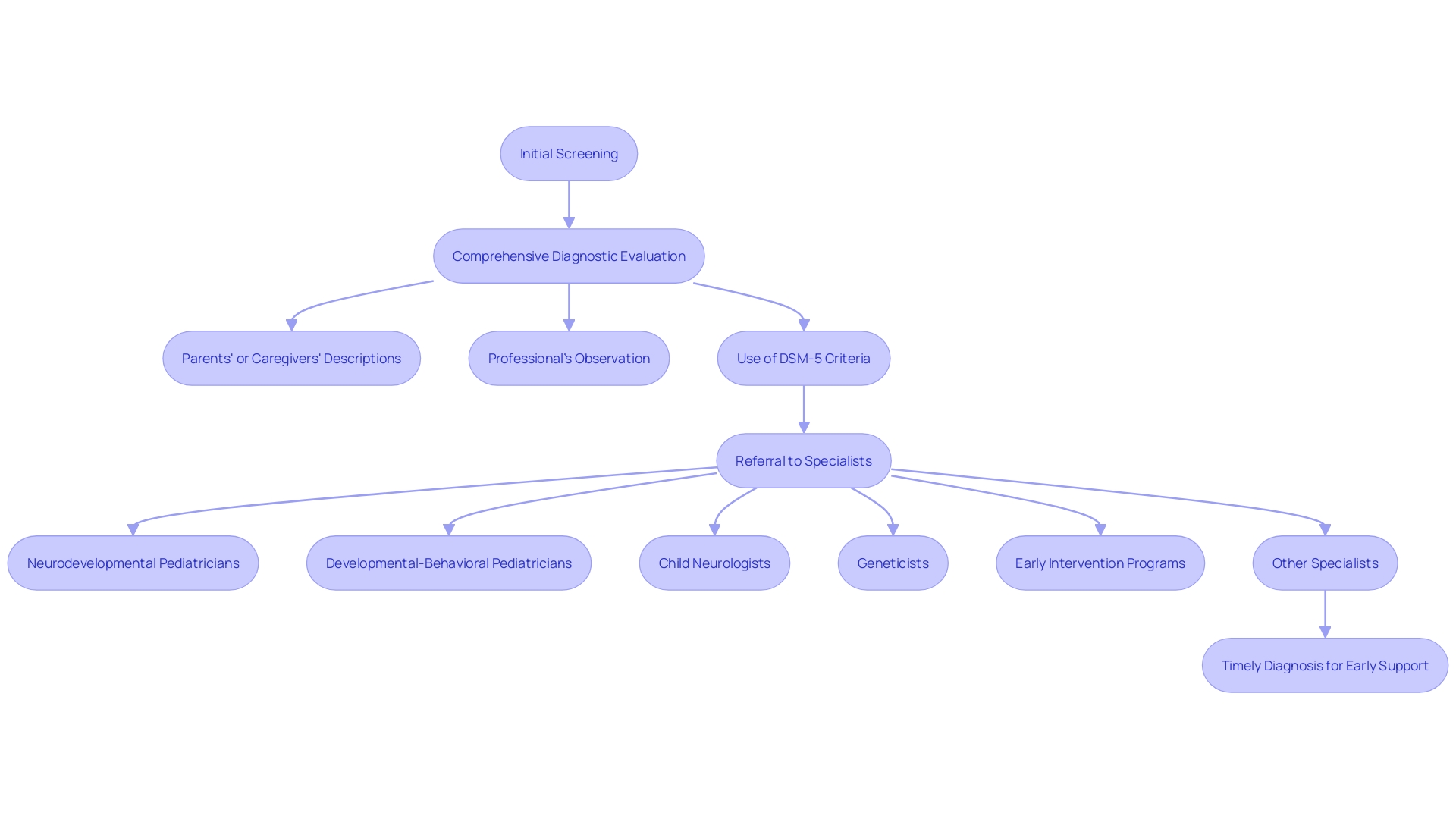
Components of a Comprehensive Evaluation
A comprehensive assessment for developmental disorders generally involves multiple essential elements to guarantee a complete grasp of the individual's strengths and difficulties. The assessment frequently starts with thorough accounts from parents or caregivers regarding the individual's development, which are vital for offering context and understanding of the person's behavior over time. This is combined with expert assessments, where specialists observe and engage with the young individual to identify behaviors suggestive of a spectrum condition.
Tools such as the American Psychiatric Association's Diagnostic and Statistical Manual, Fifth Edition (DSM-5), provide standardized criteria for diagnosing ASD, but it is important to note that no single tool should be the sole basis for diagnosis. Instead, a combination of assessments, including developmental screenings and behavioral evaluations, is used to form a comprehensive picture.
In some cases, children may be referred to specialists like neurodevelopmental pediatricians, developmental-behavioral pediatricians, or child neurologists for further assessment. 'Early childhood programs, which are highly recommended, aim to enhance social communication and tackle core challenges associated with autism.'. Evidence suggests that these interventions, such as naturalistic developmental behavioral interventions, can significantly enhance social communication skills in interactions with caregivers.
Recent advancements in technology, such as the use of artificial intelligence (AI) to analyze photographs of young ones' retinas, are also being explored as potential diagnostic tools. These innovative approaches emphasize the continuous efforts to enhance and perfect the precision of developmental assessments, ensuring that young individuals receive the timely and suitable assistance they require.
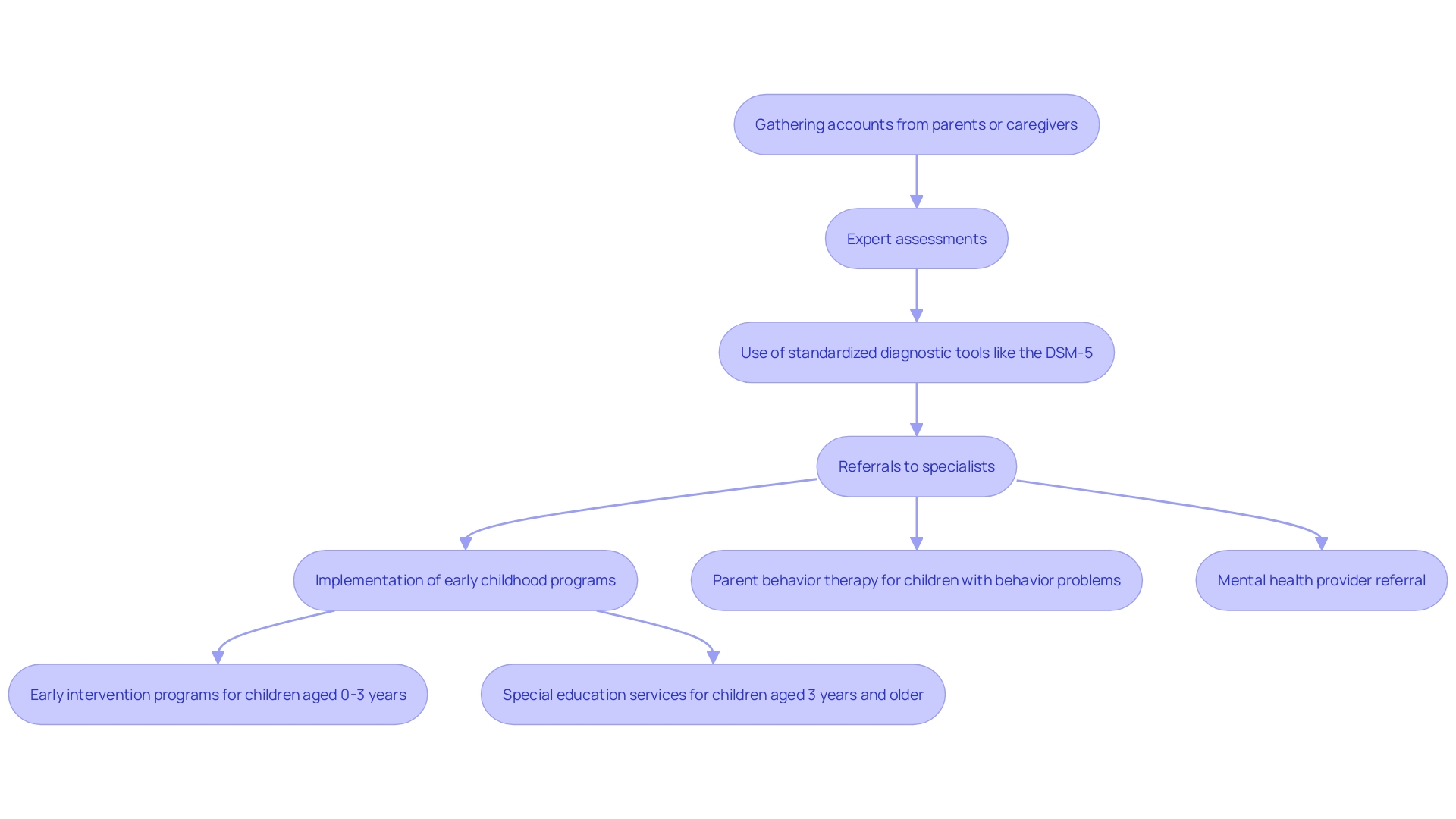
Developmental History
Gathering a thorough developmental history is crucial for an accurate diagnosis of the condition. This history should encompass details about the young one's early milestones, health records, and any concerns raised by parents or caregivers. Research indicates that 63.1% of autism screening tests consist of questionnaires filled out by parents, as they possess the most intimate knowledge of their offspring's emotions and behaviors. However, these tests often do not pinpoint specific skills needing development, which can be critical for creating individualized development plans. For a thorough diagnostic process, psychologists typically employ 3-5 different tests to assess each individual's unique strengths and challenges. This method is essential due to the fact that youth development can be inconsistent, and prompt action is vital. Research suggests that prompt action can greatly enhance social interaction and other fundamental difficulties related to developmental disorders, improving long-term results for young individuals. By understanding and documenting a young person's developmental history, parents and professionals can better navigate the autism diagnosis process and access the necessary resources and support.
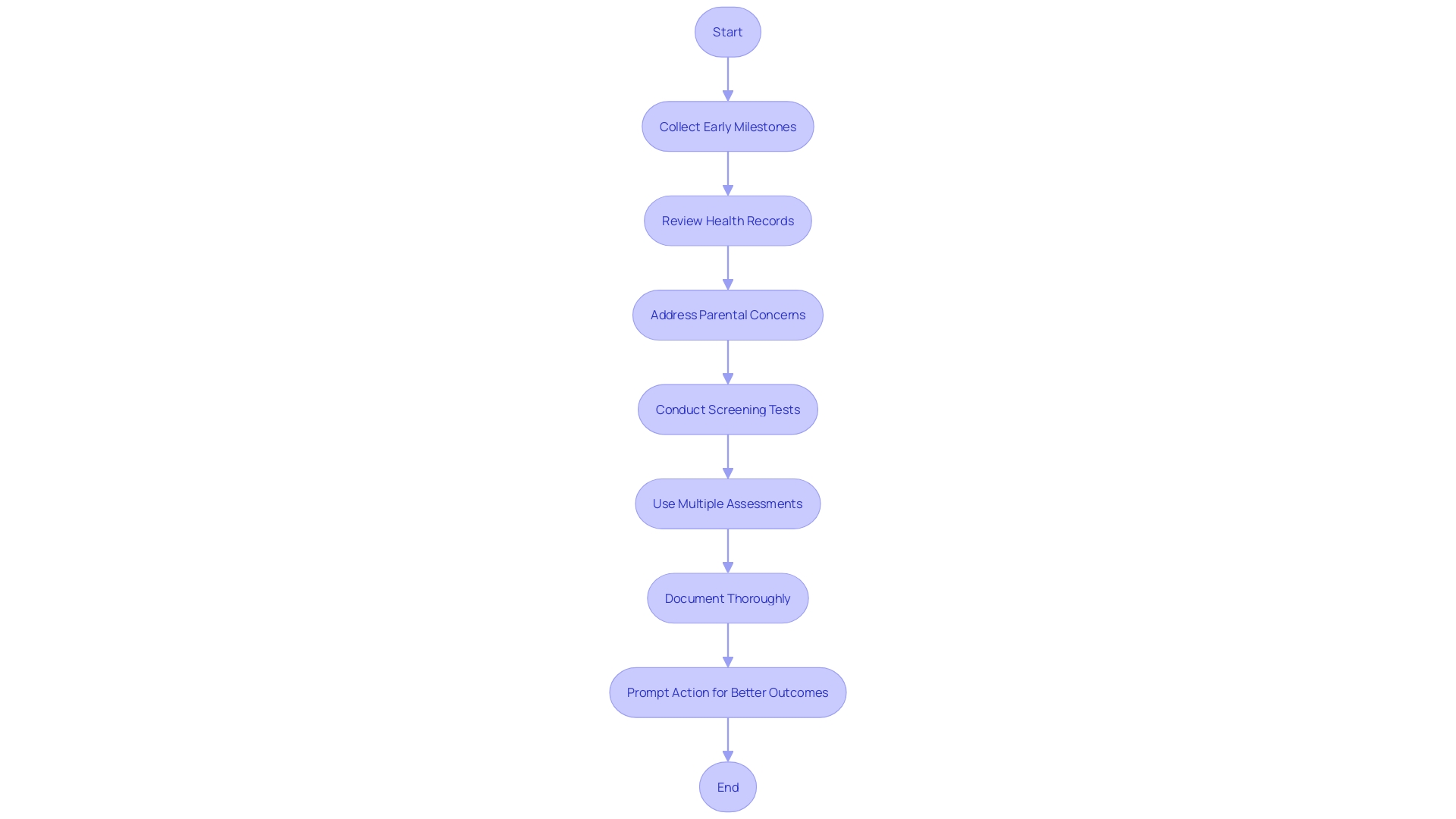
Medical History
Gathering a thorough medical history is essential for professionals to recognize any underlying health issues that may affect a young person's development and behavior. Autism spectrum disorder (ASD) often coexists with other medical conditions, and addressing these can significantly enhance a child's overall well-being. For instance, conditions such as atypical sensory perception or motor abilities, commonly associated with autism, can be better managed when healthcare providers are fully informed. Studies show that prompt action, particularly during the ideal neuroplasticity phase, can result in significant advancements in social communication and adaptive behaviors. However, delays in diagnosis, often due to long wait times for evaluations, obstruct timely assistance opportunities. According to the Autism Community in Action (TACA), addressing co-occurring medical conditions can enhance a young person's health, communication, and socialization. This comprehensive method highlights the significance of a thorough medical background in enabling timely and efficient interventions, ultimately aiding in improved long-term results for young individuals with developmental disorders.
Behavioral Observation
Direct observation of a young person's behavior across various settings is essential for a thorough evaluation of developmental disorders. This approach allows professionals to witness firsthand how the young individual navigates social interactions and responds to various stimuli. According to the American Psychiatric Association's DSM-5, observation is one of the key components in diagnosing Autism Spectrum Disorder (ASD). Experts utilize uniform standards to recognize essential characteristics of the condition, which frequently manifest by the age of three, although prompt identification is advised.
Watching a child's naturalistic play and shared focus during these assessments offers important understanding of their social communication abilities, a primary difficulty in the condition. Studies have demonstrated that prompt assistance, facilitated by parental support, greatly enhances social communication in toddlers with or vulnerable to autism. Dr. Hannah Schertz, a professor at Indiana University Bloomington, emphasizes the importance of guiding parents to promote social communication, as it is critical to address these concerns early.
Moreover, a thorough meta-analysis conducted by Michael Sandbank, PhD, emphasizes the variability in treatment approaches and the necessity for high-quality studies to support clinical practices. His research emphasizes the significance of observing possible negative impacts of actions, promoting openness with families regarding the evidence context.
Ultimately, direct observation, combined with parental input and standardized diagnostic tools, equips practitioners to develop tailored interventions. This ensures that young individuals receive the appropriate support to enhance their social communication abilities and overall development.
Cognitive and Language Assessments
To accurately gauge a young person's developmental level and communication abilities, various assessments of cognitive capacities and language skills are conducted. These evaluations often rely on standardized tools and criteria, such as those outlined in the American Psychiatric Association's Diagnostic and Statistical Manual, Fifth Edition (DSM-5). Key sources of information include detailed accounts from parents or caregivers about the development of the young one and direct observations by professionals.
In some instances, primary care providers may refer the young patient to specialists, such as neurodevelopmental pediatricians, neurologists specializing in youth, or geneticists, for further evaluation. This comprehensive approach ensures a thorough understanding of the young individual's abilities across different domains, such as communication, cognition, and social interaction, which can vary significantly.
The assessments also benefit from recent advancements in technology, though experts like Dr. Leandra Berry emphasize the continued importance of human clinical judgment in delivering and interpreting these diagnostic results. This mix of professional insights and strong diagnostic criteria aims to provide a clear picture of the young individual's developmental and communicative profile, facilitating early and effective intervention.
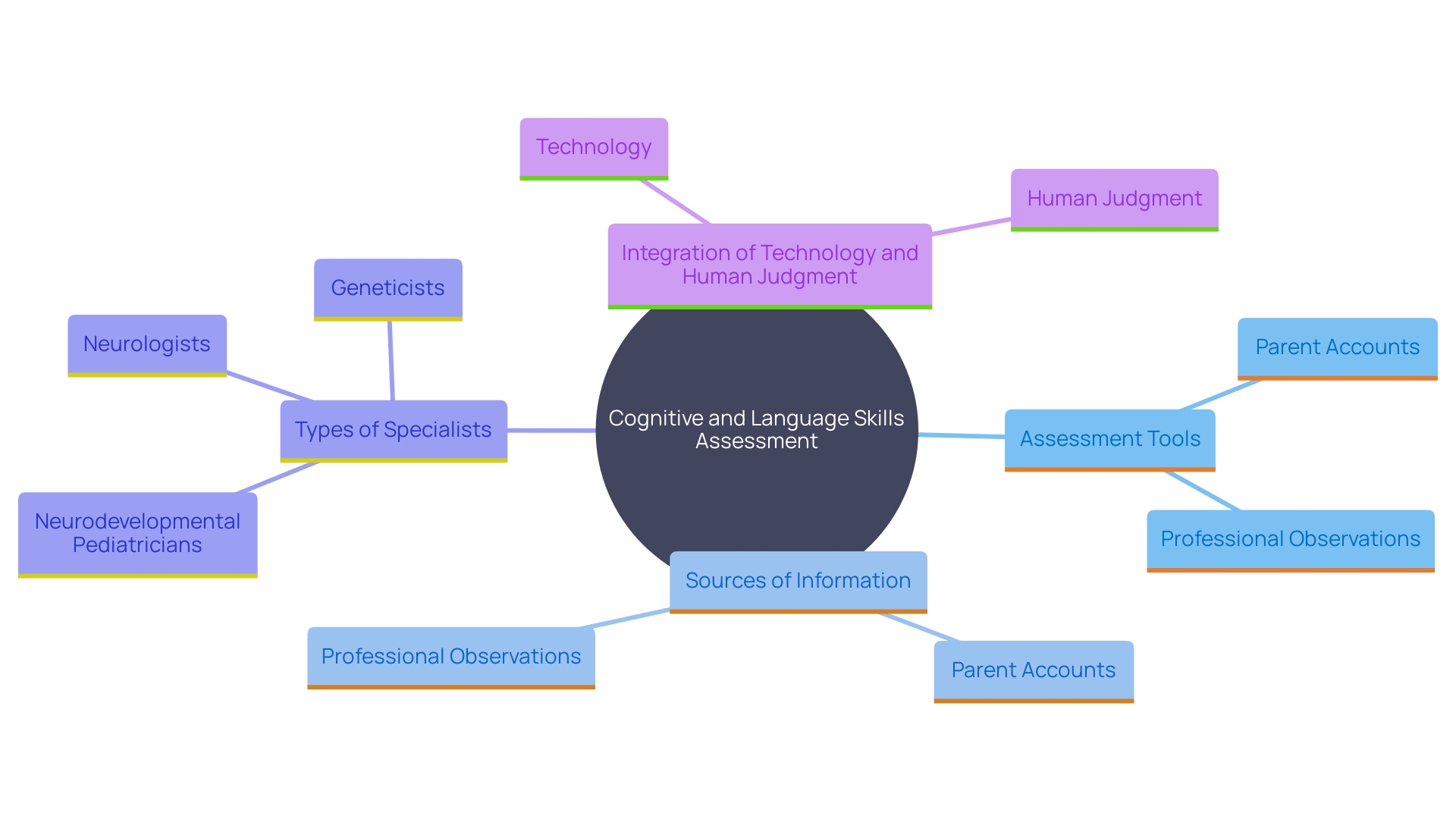
Diagnostic Instruments
During the comprehensive evaluation for autism spectrum disorder (ASD), specific diagnostic instruments play a crucial role in ensuring an accurate diagnosis. These tools depend significantly on two main sources of information: detailed descriptions from parents or caregivers about the individual's developmental history and professional observations of the individual's behavior. According to the American Psychiatric Association's Diagnostic and Statistical Manual, Fifth Edition (DSM-5), standardized criteria are used to guide the diagnostic process. Various tools, such as the Autism Diagnostic Observation Schedule (ADOS) and the Childhood Autism Rating Scale (CARS), are employed to assess different aspects of a young person's development and behavior. However, no single tool should be solely relied upon for diagnosis. In certain instances, primary care providers might direct families to specialists, such as neurodevelopmental pediatricians, developmental-behavioral pediatricians, or neurologists for additional assessment. This multidisciplinary approach aids in guaranteeing a comprehensive and precise evaluation, which is crucial considering the rising incidence of ASD, now estimated at one in 36 youths in the United States.
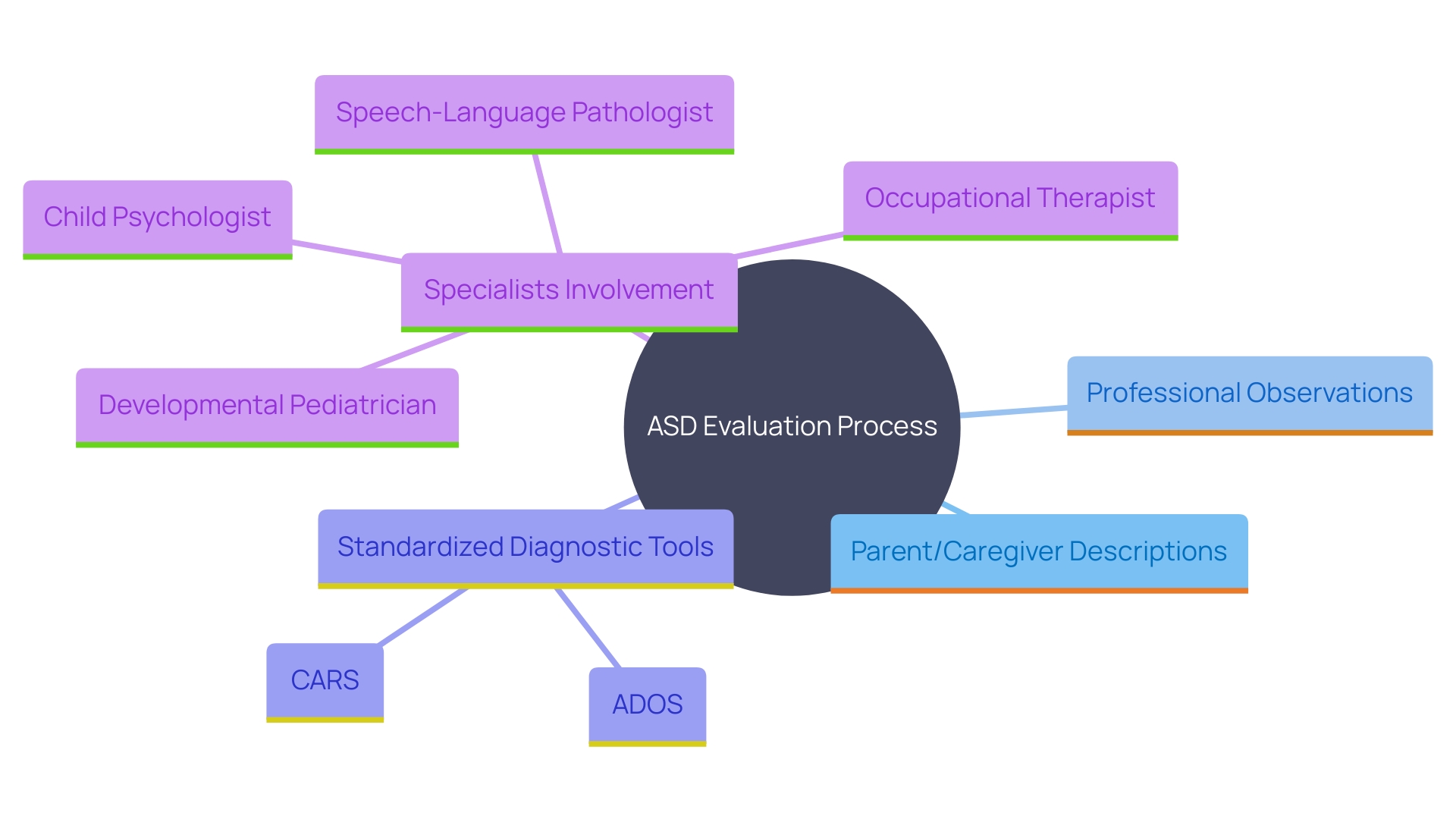
Autism Diagnostic Observation Schedule, Second Edition (ADOS-2)
The ADOS-2, or Autism Diagnostic Observation Schedule, Second Edition, is a widely used standardized assessment tool. It involves structured interactions designed to observe specific behaviors and social communication skills in young individuals. By focusing on direct observations during these interactive sessions, the ADOS-2 provides essential information that can help identify symptoms of autism spectrum disorder (ASD). This tool is frequently utilized together with additional diagnostic techniques and expert assessments, ensuring a thorough approach to understanding a young person's developmental profile.
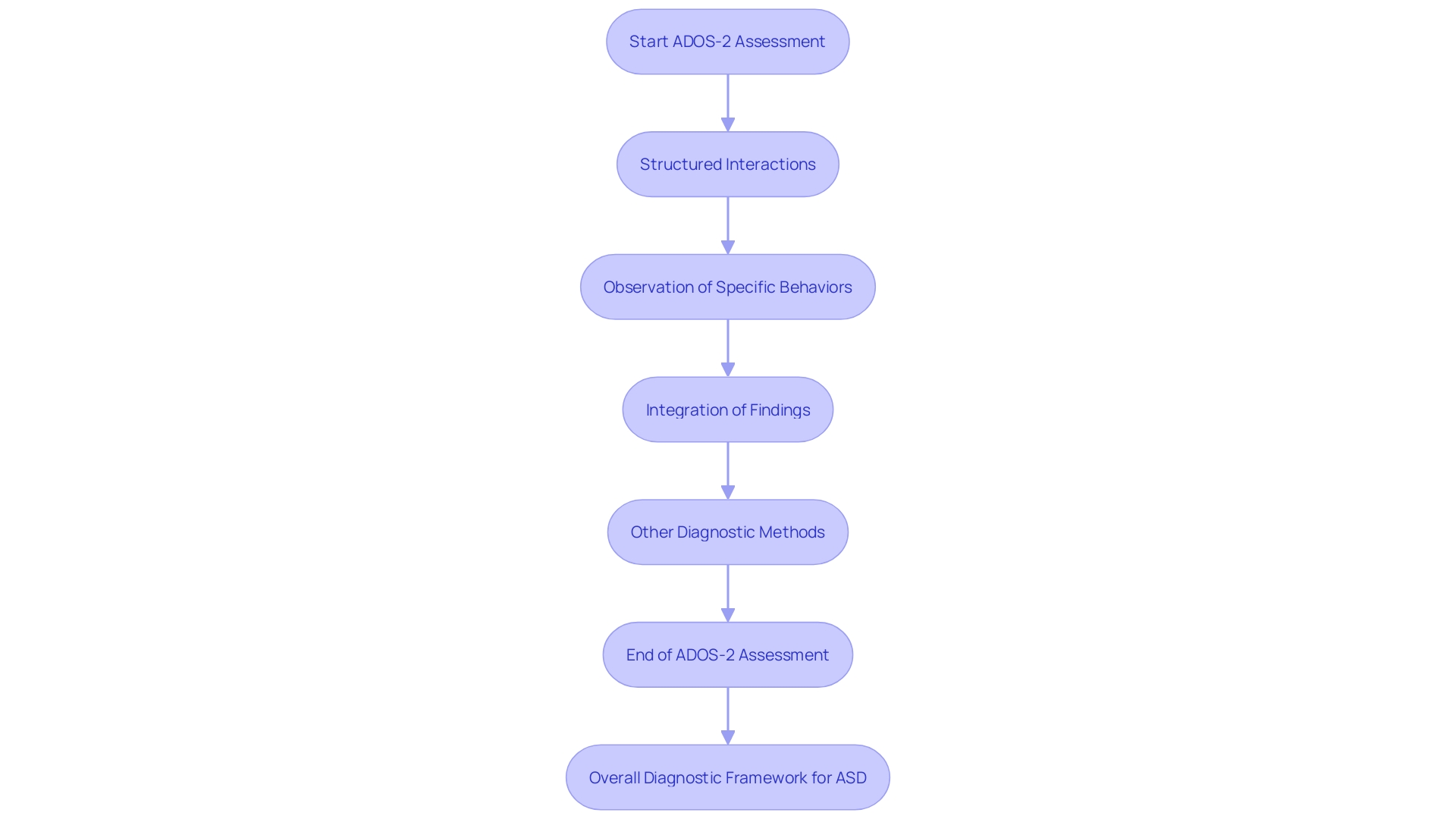
Autism Diagnostic Interview, Revised (ADI-R)
The Autism Diagnostic Interview-Revised (ADI-R) is a comprehensive, structured interview conducted with parents to gather detailed information about their offspring's developmental history and current behavior. This tool is essential in the diagnostic process as it aligns with the DSM-5 criteria for Autism Spectrum Disorder (ASD), which requires that core features of autism be present during childhood. However, symptoms may not fully manifest until social demands exceed the individual's capacity to cope. By using the ADI-R, clinicians can obtain invaluable insights from parents about their offspring's communication, social interactions, and repetitive behaviors, which are essential for accurate diagnosis and early intervention. The ADI-R, combined with professional observations and other diagnostic tools, ensures a thorough assessment of the individual's developmental and behavioral profile.
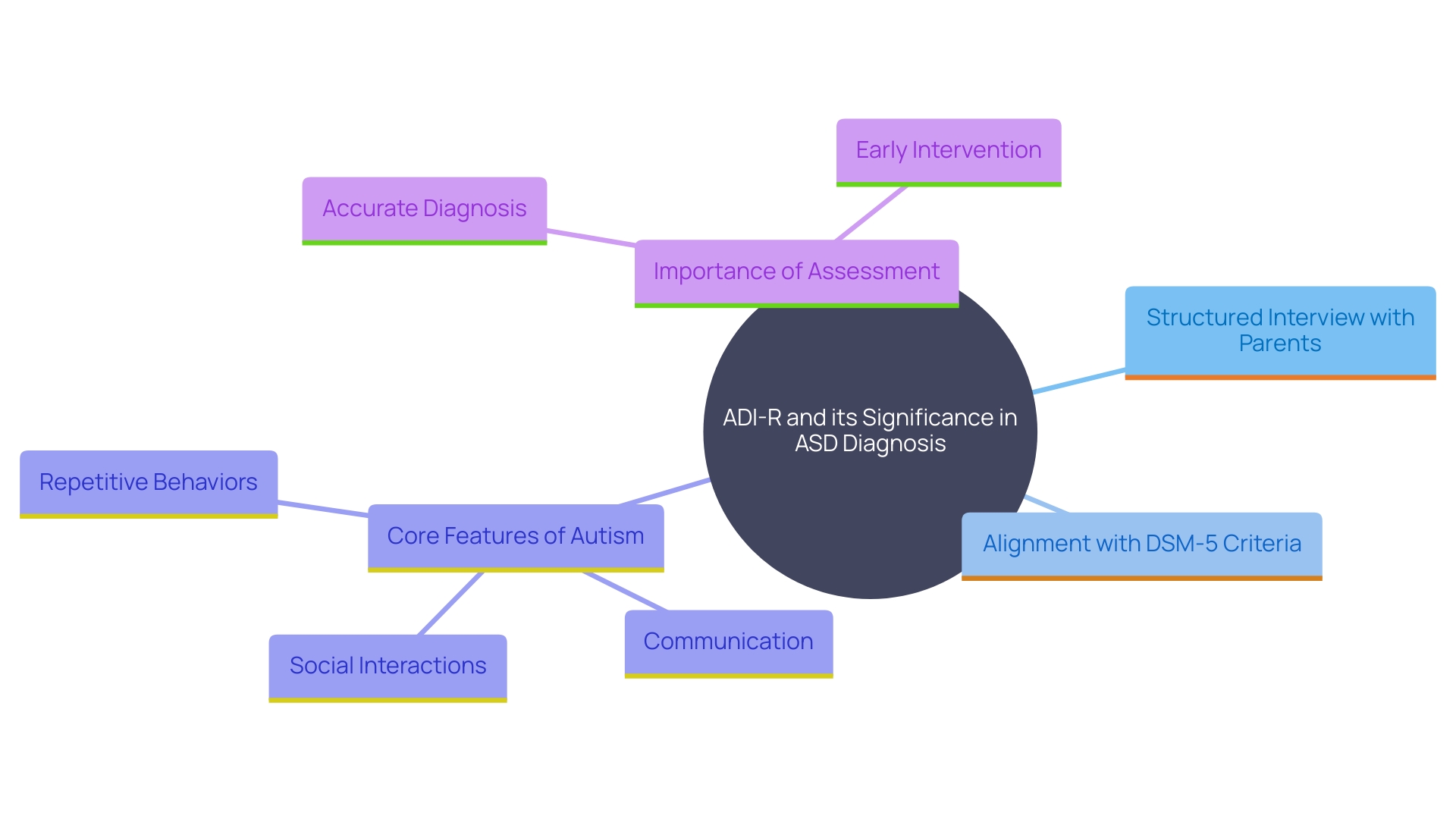
Childhood Autism Rating Scale (CARS)
The Childhood Autism Rating Scale (CARS) is a vital tool in identifying developmental disorders in children and assessing the severity of their symptoms. It evaluates behavior across multiple domains, including social communication and interaction, which are core challenges associated with autism. Prompt actions, such as behavioral and naturalistic developmental behavioral strategies, have demonstrated substantial enhancements in these areas. For instance, developmental programs improved social communication with caregivers (Hedges’ g=0.28), while naturalistic developmental behavioral strategies enhanced adaptive behavior (0.23) and play (0.19). These measures are essential, as prompt identification and action can greatly influence a young person's long-term developmental results. Regrettably, holdups in identification are frequent, with some youngsters waiting as long as three years for an evaluation, missing vital initial support opportunities. CARS plays an essential role in enabling prompt and precise diagnosis, assisting in closing this gap and supporting initial action efforts.
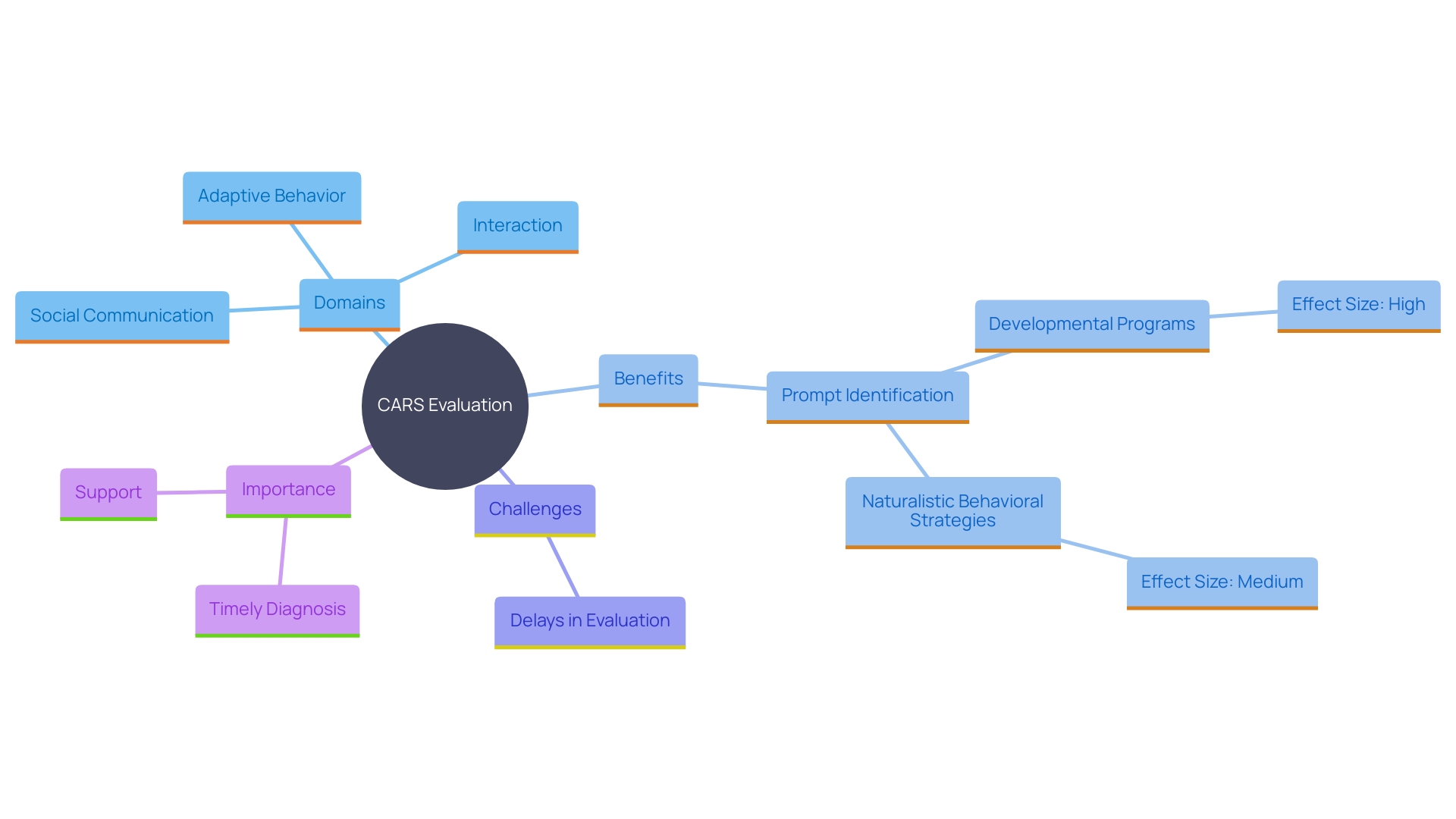
Preparing for the Diagnostic Appointment
Preparing for a diagnostic appointment is crucial for a comprehensive evaluation. Parents should gather all relevant documents, including developmental history, previous assessments, and any notes on observed behaviors. This preparation can significantly reduce the wait time for an assessment, which can often extend beyond four months and, in some cases, over a year. 'Based on research by Scott Badesch, a past leader of the Autism Society of America, the delays in diagnosis result in youngsters missing chances for prompt assistance, which are essential during the initial neurodevelopmental phase.'. Ensuring all necessary documentation is ready helps streamline the process and supports a more efficient evaluation. Furthermore, recognizing that early intervention is crucial can enable families to pursue prompt and suitable assistance for their offspring.
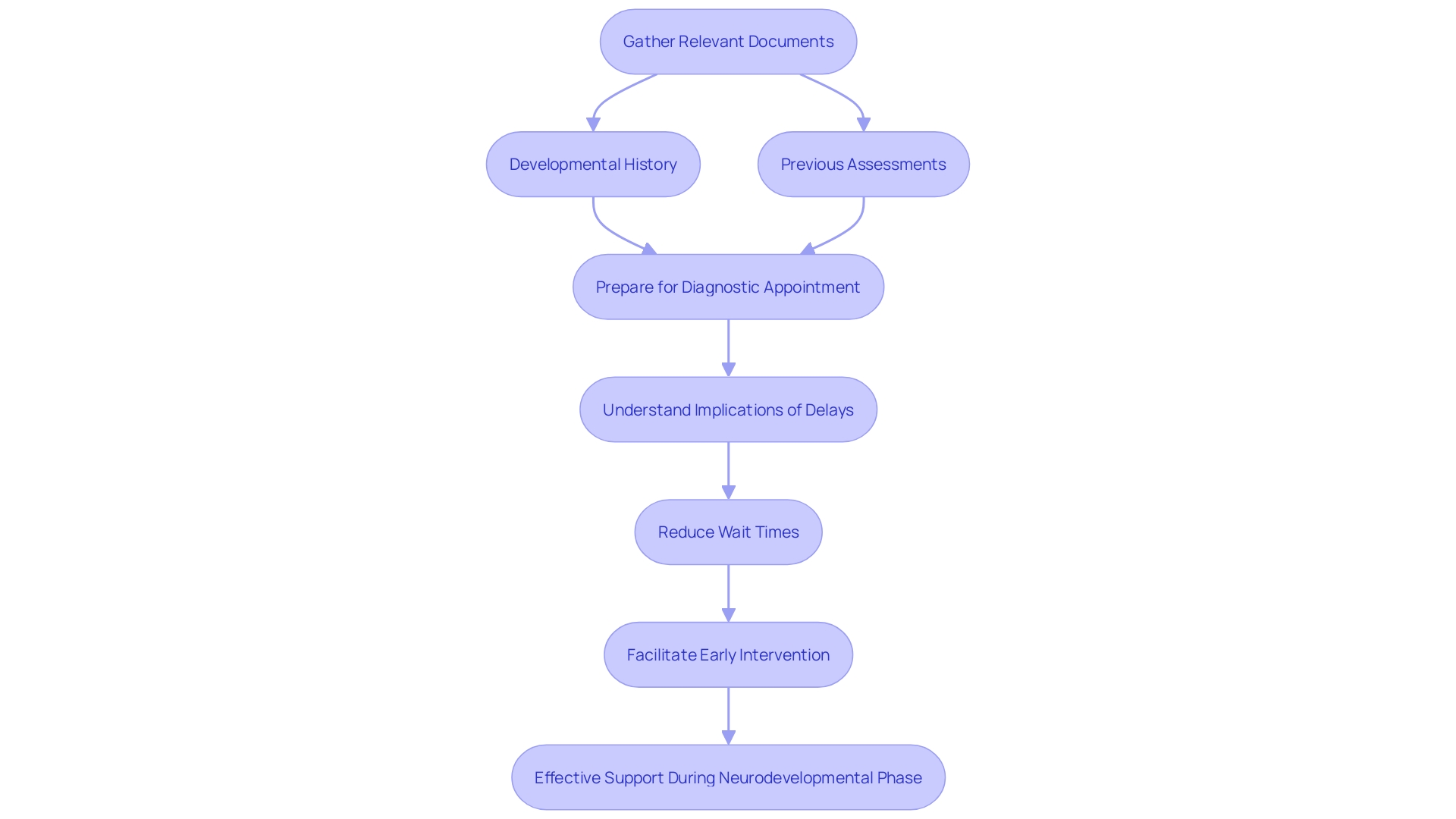
What to Expect During the Evaluation
During the evaluation process for developmental conditions, parents should anticipate a multifaceted approach that includes a combination of interviews, observations, and standardized tests. Identifying spectrum disorder (ASD) mainly depends on two key sources: accounts from parents or caregivers regarding the young person's development and direct observations of the young person's behavior by experts. The American Psychiatric Association's Diagnostic and Statistical Manual, Fifth Edition (DSM-5), provides standardized criteria to aid in this diagnosis.
The assessment frequently starts with comprehensive discussions where parents share information about their offspring's medical history, reasons for suspecting autism, and specifics regarding their behaviors and thought processes. These interviews are crucial as they offer insights that help professionals understand the individual's unique needs.
Observations by professionals play a vital role as well. These can occur during structured activities or in natural settings, such as the individual's home or school, to get a comprehensive view of their interactions and behaviors. Standardized tests and diagnostic tools may be used to assess specific areas such as communication skills, social interactions, and repetitive behaviors.
The process may vary depending on the resources available, the age of the young person, and the specific symptoms presented. Some evaluations might involve multiple appointments and various forms to ensure a thorough assessment. It is important to recognize that no single tool should be used as the sole basis for diagnosis. In certain situations, the primary care provider might refer the young patient to specialists such as neurodevelopmental pediatricians or neurologists for further evaluation.
Grasping this process is crucial for parents as it offers a clearer view of their offspring's needs and assists in obtaining suitable support and assistance.
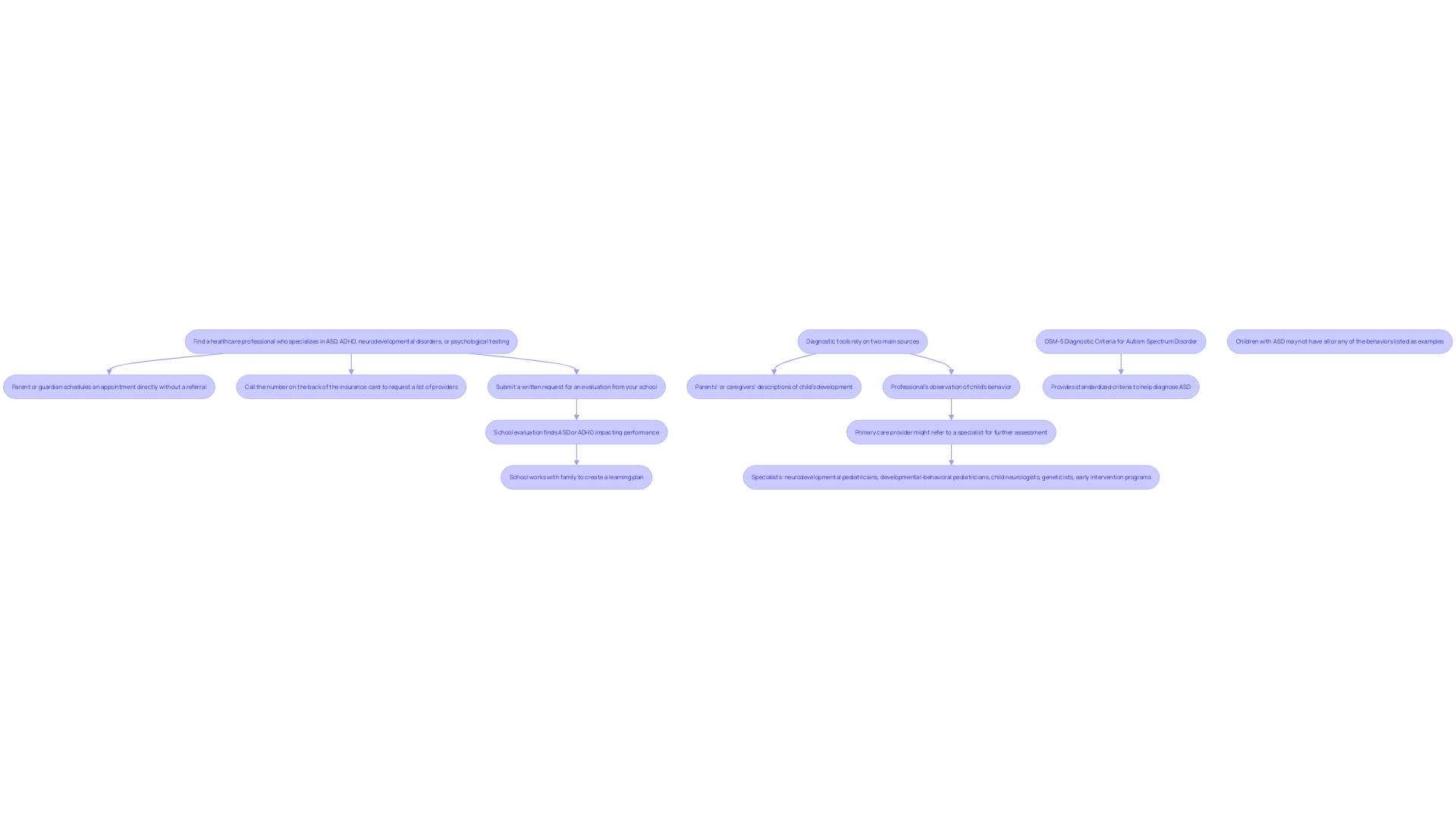
Understanding the Diagnostic Report and Recommendations
Upon completion of the evaluation, parents will be provided with a comprehensive diagnostic report detailing the findings and tailored recommendations. This document is essential for planning meaningful interventions and supports that cater to the individual's unique needs. The diagnostic report typically includes information derived from both caregivers’ accounts of the young one's developmental history and professional observations of the young one's behavior. Utilizing standardized criteria from the DSM-5, professionals ensure a reliable diagnosis of autism spectrum disorder (ASD). The report serves as a vital tool to guide parents and professionals in implementing effective strategies and accessing appropriate services, thereby fostering the child’s development and well-being.
Conclusion
Understanding the journey of autism diagnosis is crucial for parents and caregivers seeking the best outcomes for their children. The two-step process of screening and comprehensive evaluation ensures that children receive timely assessments and appropriate interventions. Early developmental screenings serve as the first line of defense, allowing professionals to identify potential signs of autism and guide families toward necessary evaluations.
The importance of these screenings cannot be overstated, as they lay the groundwork for early interventions that can significantly enhance social communication and adaptive behaviors.
The comprehensive evaluation that follows is vital in providing a thorough understanding of a child's strengths and challenges. By utilizing a combination of parent input, professional observations, and standardized diagnostic tools, a complete picture of the child's developmental trajectory emerges. This multifaceted approach not only aids in accurate diagnosis but also facilitates the creation of tailored interventions that address the unique needs of each child.
The emphasis on early diagnosis and intervention highlights the critical window of opportunity during the first few years of life when interventions can have the most profound impact.
In conclusion, navigating the autism diagnostic process can be daunting, but understanding its components empowers parents and caregivers to advocate for their children effectively. By recognizing the significance of early screenings and comprehensive evaluations, families can take proactive steps toward securing support and resources that foster their child's development. The journey may be complex, but with the right knowledge and tools, families can ensure that their children receive the care and interventions they deserve, ultimately paving the way for brighter futures.




